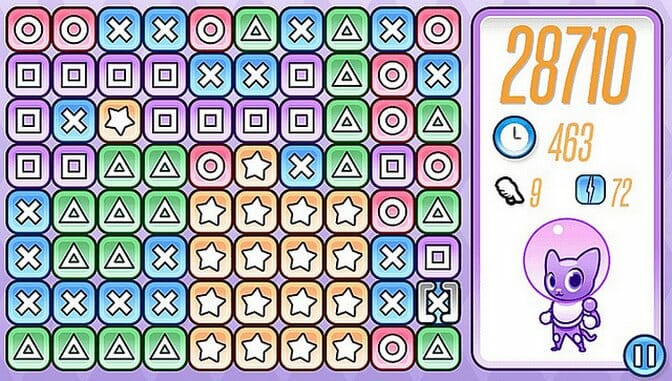Ten By Eight (Vita)

I never realized my fingers were so greasy. My Vita screen becomes a smudged up mess whenever I play Ten By Eight, the new tile-matching puzzle game from Action Button Entertainment. Action Button Entertainment was formed by Tim Rogers, writer and founder of actionbutton.net, to put his single button game philosophy into practice. Ten By Eight’s single button is the entirety of the Vita’s screen, and I make a total mess of that button whenever I play this game, even when I haven’t eaten in hours, even when I wash my hands immediately before playing.
I know I’m doing well when that smudge covers most of the screen. Ten By Eight is a ten by eight grid filled with tiles of different colors. I can slide those tiles around the screen, swapping positions between them, as long as they are adjacent to tiles of the same color. When I drag my finger over a chain of three or more same-colored tiles, they’ll disappear, popping some points over into my score total. Tiles will fall to fill those gaps, and new tiles will appear from the top of the screen, guaranteeing that there are always eighty tiles on the grid. The goal is to create as long of a chain as possible, with bonus points for stretching from any one end of the grid to the opposite side.
Special star tiles let me glide from one color into another. I can arrange a string of ten green tiles and a string of fifteen red tiles and if there’s a star tile in-between I can move effortlessly from green to red. Stars also multiply the point value of any string, so the more star tiles I touch the better. A string that hits all four edges of the grid and also includes a bunch of star tiles will lead to an absurdly high score. That’s crucial, as points are the ultimate goal of each session, and, along with the nebulous notion of fun, the only reason to play the game.
Those points are needed to unlock new characters (which don’t really impact the actual game at all, and some of which will be familiar to fans of Action Button’s Ziggurat). They are the only unlockables and the only way to unlock them is by hitting certain career point thresholds. Unlocking them isn’t a challenge—points are collected together from every game played across Ten By Eight’s three modes, so anybody who sticks with the game long enough will inevitably unlock every character. Again, though, these characters only make an aesthetic contribution, and I rarely deviate from the adorable octopus whose head looks like the moon.
I also largely stick to the timed game mode, which is unusual for me. Endless modes tend to offer the best version of any puzzle game, but Ten By Eight’s two untimed modes are slightly problematic.
The officially designed endless mode scatters rocks around the grid, and a rock can only be removed if I create a chain that fully surrounds it. Even with unlimited time to plan, it can be difficult to swallow that tail and make the rocks disappear. An endless game ends when a rock touches the bottom of the grid. It’s more frustrating than I’d like it to be.
The zen mode still keeps score (which isn’t very zen) but there are no rocks and no timer. It’s a no-pressure chance to construct as large of a chain as I can find. It’s a fine practice mode but the lack of any limitations removes any sense of danger or expediency. It’s a good way to build points for unlocking new critters, but the simple satisfaction of building chains isn’t substantial enough to stand on its own without some form of risk.
